The Economics and Statistics Division maintains archives of previous publications for accountability purposes, but makes no updates to keep these documents current with the latest data revisions from Statistics Canada. As a result, information in older documents may not be accurate. Please exercise caution when referring to older documents. For the latest information and historical data, please contact the individual listed to the right.
<--- Return to Archive
For additional information relating to this article, please contact:
November 18, 2021EMPLOYMENT INSURANCE, SEPTEMBER 2021 From March to September, Statistics Canada suspended publication of employment insurance (EI) statistics. Canadians were eligible for the Canada Emergency Response Benefit (CERB) during this period. New data for the period from March to September shows how an initial rise in EI claims at the start of the pandemic was reversed as new EI applicants were directed to CERB instead. After September 27, 2020 there was a temporary expansion of EI and CERB recipients were transitioned back to EI. Temporary changes were introduced to the EI program, including a reduction in the number of insurable hours required for eligibility.
The new information for September 2021 reflects the period of September 12 to 18. At this time, several provinces had announced plans for proof-of-vaccine requirements to enter non-essential businesses. Alberta reintroduced alcohol service curfew as of September 4th and employers were urged to pause return-to-work plans. On September 14, Nova Scotia postponed entering its final phase of reopening.
In September, there were 63,310 Nova Scotians in receipt of regular EI (seasonally adjusted) benefits. Nova Scotia's seasonally adjusted regular EI usage rose by 520 (+0.8%) from August to September 2021.
About 1.28 million Canadians received regular EI benefits in September (seasonally adjusted), a decrease of 186,520 (-12.7%) from August. Ontario, Alberta and Manitoba reported the largest percentage declines in beneficiaries. EI recipients were lower in eight provinces and went up in Nova Scotia and New Brunswick.

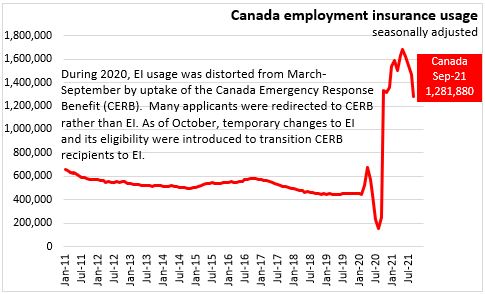
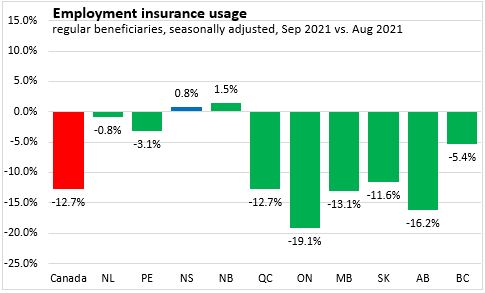
As a percentage of the labour force, employment insurance beneficiaries reflect 12.5% of the labour force in Nova Scotia. Nationally, the share of beneficiaries was 6.2% of the labour force in September. Employment insurance beneficiaries reflect a larger share of the labour force in Atlantic Canada.

When compared to February 2020, EI usage has increased 187.2% across Canada as of September 2021. In Nova Scotia, EI usage was up 148.4% compared to the pre-pandemic benchmark. The largest percentage increases in EI usage were in British Columbia and Ontario. The lowest increases in EI usage were reported in Atlantic Canada and Saskatchewan.
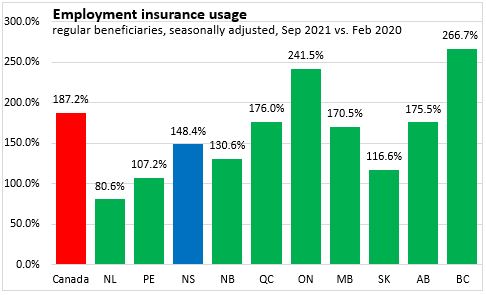
By age and sex cohort, the increase in EI usage has been notably higher among women since the onset of the pandemic (Sep 2021 vs Feb 2020, seasonally adjusted). Prior to the pandemic, women had lower EI usage compared to men. The industries whose employment was most affected by public health restrictions and other pandemic precautions had a disproportionate share of female employment. In late September 2020, temporary changes to the EI program, including a reduction in the number of insured hours required to qualify, resulted in an increased number of women aged 15-24 and persons working in retail trade who received benefits.
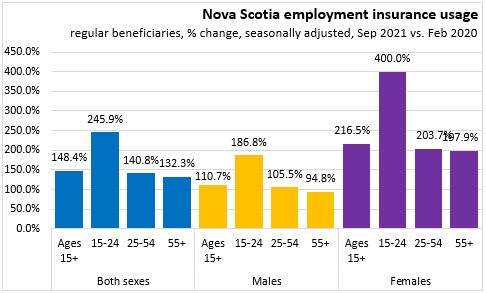

In September 2021, EI beneficiaries reflect a larger share of the labour force for males and for those aged 55 and over. EI recipients as a share of the labour force was higher for males than females for every age cohort.

All occupational categories saw increases in EI usage in Nova Scotia for January-September 2021 compared to the same period in 2019. Sales and service occupations reflect the largest number of beneficiaries, and also saw the largest increase in usage compared to before the pandemic. Trades and transportation occupations were the second largest usage category, followed by natural resources and agriculture, manufacturing and utilities, and business, finance and administration.
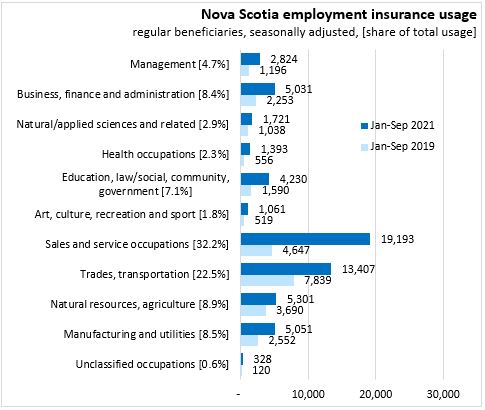
Among counties (comparing unadjusted results for September 2021 with September 2019), EI usage increased the most in Halifax, Queens and Cumberland counties. Increases in EI usage were lowest in Inverness and Richmond.
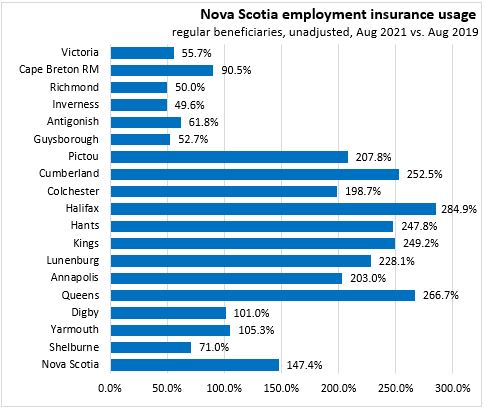
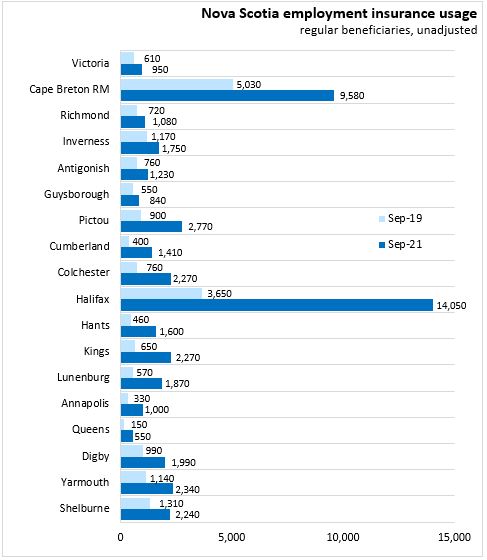
By economic region, employment insurance usage was highest in Halifax in September 2021, followed by Cape Breton. As a share of the labour force, employment insurance usage was highest in Cape Breton and lowest in Halifax.
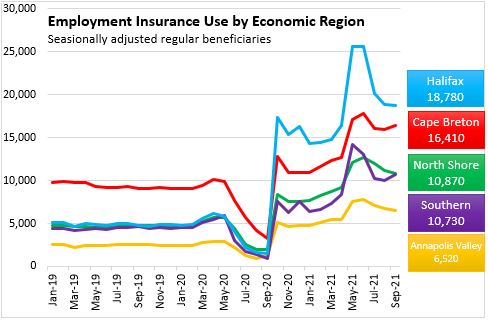
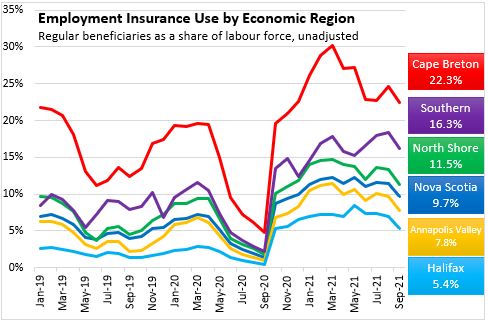
Across the country in most economic regions, employment insurance beneficiaries as a share of the labour force has increase compared to the pre-pandemic benchmark of February 2020.
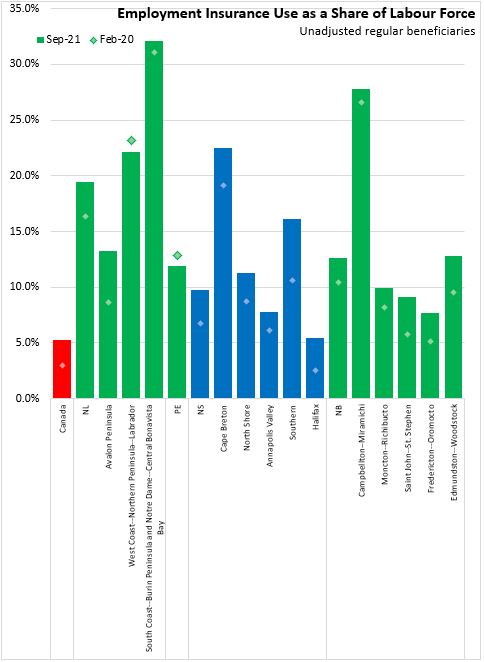
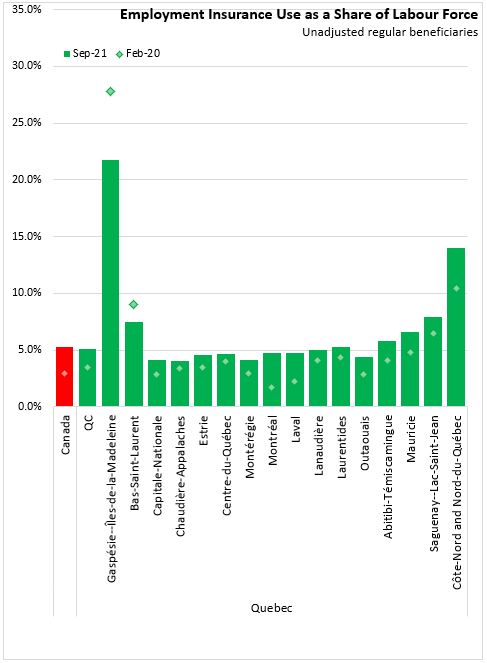
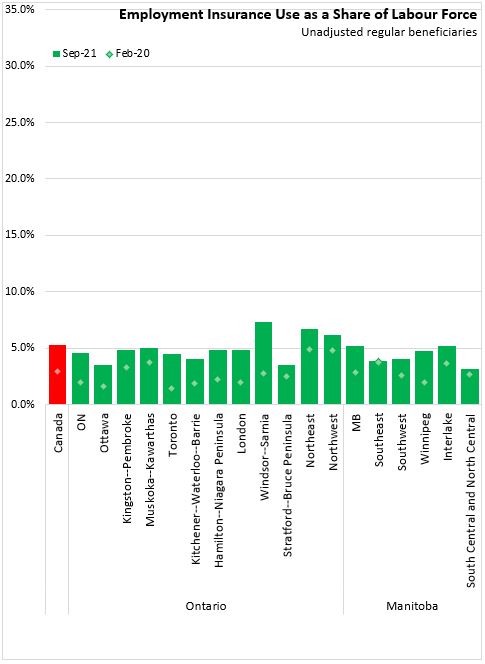
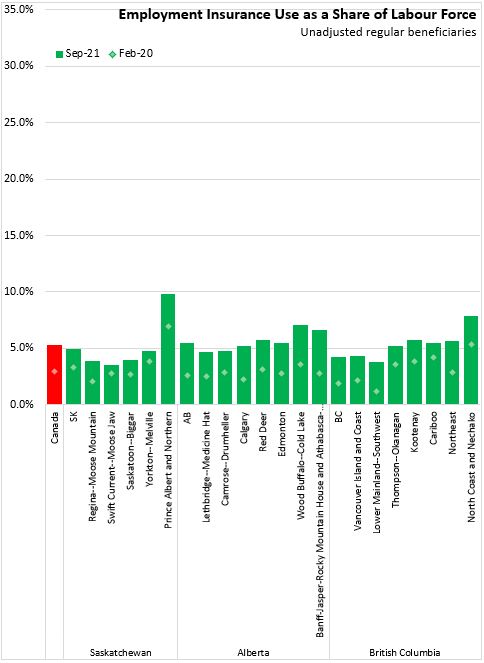
Source: Statistics Canada. Table 14-10-0011-01 Employment insurance beneficiaries (regular benefits) by province and territory, monthly, seasonally adjusted
Table 14-10-0323-01 Employment insurance beneficiaries by census division, monthly, unadjusted for seasonality
Table 14-10-0337-01 Employment insurance beneficiaries (regular benefits) by province, territory and occupation, monthly, seasonally adjusted
Table 14-10-0287-01 Labour force characteristics, monthly, seasonally adjusted and trend-cycle, last 5 months
Table 14-10-0343-01 Employment Insurance beneficiaries by economic region, monthly, unadjusted for seasonality
Table 14-10-0387-01 Labour force characteristics, three-month moving average, unadjusted for seasonality, last 5 months
Table 14-10-0344-01 Employment Insurance beneficiaries (regular benefits) by economic region, monthly, seasonally adjusted
<--- Return to Archive